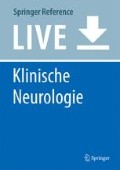Zusammenfassung
Die Syringomyelie ist gekennzeichnet durch röhrenförmige, flüssigkeitsgefüllte Aushöhlungen im Rückenmark. Es kommt zu einem charakteristischen zentralen Rückenmarksyndrom, dessen Leitsymptom die dissoziierte Sensibilitätsstörung ist. Fehlbildungen des kraniozervikalen Übergangs sind oft assoziiert; der untere Hirnstamm kann einbezogen sein (Syringobulbie). Die Behandlung ist nach Möglichkeit operativ und zielt auf die Normalisierung der zerebrospinalen Liquorzirkulation ab. In Fällen, wo keine kausale Operationsmaßnahme (z. B. Beseitigung von Fehlbildungen oder Raumforderungen) zur Verfügung steht, kann die operative Drainage der intrakavitären Flüssigkeit die Symptomatik bessern oder zum Stillstand bringen. Voraussetzung für die Entscheidung über das geeignete Operationsverfahren ist die Aufklärung der Ätiologie im Individualfall und die genaue anatomische Darstellung der Höhlenbildung mittels MRT. Unbehandelt ist der Verlauf häufig chronisch-progredient und kann zur schweren Behinderung führen.
Literatur
Zitierte Literatur
Förander P, Sjavik K, Solheim O, Riphagen I, Gulati S, Salvesen O, Jakola AS (2014) The case for duraplasty in adults undergoing posterior fossa decompression for Chiari I malformation: a systematic review and meta-analysis of observational studies. Clin Neurol Neurosurg 125:58–64
Klekamp J (2013) Treatment of syringomyelia related to nontraumatic pathologies of the spinal canal. Neurosurgery 72:367–389
Kramer JL, Dvorak M, Curt A (2009) Thoracic disc herniation in a patient with tethered cord and lumbar syringomyelia and diastematomyelia: magnetic resonance imaging and neurophysiological findings. Spine 34:E484–E487
Krebs J, Koch HG, Hartmann K, Frotzler A (2016) The characteristics of posttraumatic syringomyelia. Spinal Cord 54:463–466
Kulwin CG, Patel NB, Ackerman LL, Smith JL, Boaz JC, Fulkerson DH (2013) Radiographic and clinical outcome of syringomyelia in patients treated for tethered cord syndrome without other significant imaging abnormalities. J Neruosurg Pediatr 11:307–312
Roser F, Ebner FH, Liebsch M, Dietz K, Tatagiba M (2008) A new concept in the electrophysiological evaluation of syringomyelia. J Neurosurg Spine 8:517–523
Saker E, Henry BM, Tomaszewski KA, Loukas M, Ianaga J, Oskouian RJ, Tubbs RS (2016) The human central canal of the spinal cord: a comprehensive review of its anatomy, embryology, molecular development, variants, and pathology. Cureus 8:e927
Singhal R, Perry DC, Prasad S, Davidson NT, Bruce CE (2013) The use of routine preoperative magnetic resonance imaging in identifying intraspinal anomalies in patients with idiopathich scoliosis: a 10-year review. Eur Spine J 22:355–359
Srivatanakul K, Songsaeng D, Ozanne A, Toulgoat F, Lasjaunias P (2009) Spinal arteriovenous malformation associated with syringomyelia. J Neurosurg Spine 10:436–442
Tortora F, Napoli M, Caranci F, Cirillo M, Pepe D, Cirillo S, Briganti F (2012) Spontaneous regression of syringomyelia in a young patient with Chiari type I malformation. Neuroradiol J 25:593–597
Yamada S, Tsuchiya K, Bradley WG, Law M, Winkler ML, Borzage MT, Miyazaki M, Kelly EJ, McComb JG (2015) Current and emerging MR imaging techniques for the diagnosis and management of CSF flow disorders: a review of phase-contrast and time-spatial labeling inversion pulse. AJNR Am J Neuroradiol 36:632–630
Zhang D, Papavassilio E (2017) Spinal intradural arachnoid webs causing spinal cord copression with inconclusive peroperative imaging: a report of 3 cases and an review of the literature. World Neurosurg 99:251–258
Weiterführende Literatur
Ghobrial GM, Dalyai RT, Maltenfort MG, Prasad SK, Harrop JS, Sharan AD (2015) Arachnolysis or cerebrospinal fluid diversion for adult-onset syringomyelia? A systematic review of the literature. World Neurosurg 83:829–835
Haughton V, Mardal KA (2014) Spinal fluid biomechanics and imaging: an update for neuroradiologists. AJNR Am J Neuroradiol 35:1864–1869
Author information
Authors and Affiliations
Corresponding author
Editor information
Editors and Affiliations
Rights and permissions
Copyright information
© 2018 Springer-Verlag GmbH Deutschland
About this entry
Cite this entry
Henningsen, H. (2018). Syringomyelie. In: Berlit, P. (eds) Klinische Neurologie. Springer Reference Medizin. Springer, Berlin, Heidelberg. https://doi.org/10.1007/978-3-662-44768-0_68-1
Download citation
DOI: https://doi.org/10.1007/978-3-662-44768-0_68-1
Received:
Accepted:
Published:
Publisher Name: Springer, Berlin, Heidelberg
Print ISBN: 978-3-662-44768-0
Online ISBN: 978-3-662-44768-0
eBook Packages: Springer Referenz Medizin

